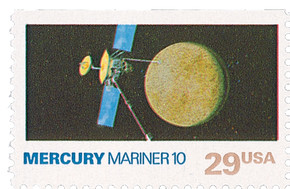
US #2574
1991 Saturn
- Part of set picturing nine planets and Earth’s moon
- Issued as part of Stamp Collecting Month
Category of Stamp: Commemorative
Set: Space Exploration
Value: 29¢
First Day of Issue: October 1, 1991
First Day City: Pasadena, California
Quantity Issued: 33,394,800
Printed by: Bureau of Engraving and Printing
Printing Method: Photogravure
Format: Booklets – 2 panes of 10 in each
Perforations: 11
Reason the stamp was issued: The set of Space Exploration stamps was issued in honor of the Voyager 2 space probe passing Neptune and the 11th annual Stamp Collecting Month.
About the stamp design: The Saturn stamp pictures the planet and the Voyager 2 space probe. The probe was launched in August 1977 to study the outer planets. It visited Jupiter, Saturn, Uranus, and Neptune.
These stamps were the first by Ron Miller, a former artist for the Smithsonian Institution’s National Air and Space Museum. He was asked to picture each of the Sun’s nine planets and the Earth’s moon with a spacecraft. This was to tie in the idea of America’s exploration of space. His original acrylic paintings were larger than those normally used for stamp art. This was to show all the details of the spacecraft.
Special design details: While most of the stamps name the spacecraft shown, the Pluto stamp has “not yet explored,” because no spacecraft had reached that planet at the time. (The space probe New Horizons explored Pluto in 2015.)
First Day City: The First Day of Issue ceremony took place at the Jet Propulsion Laboratory in Pasadena, California, on October 1, 1991, the start of Stamp Collecting Month.
Unusual thing about this stamp: The USPS partnered with Paramount Studios to promote the stamps. The studio was celebrating the 25th anniversary of the Star Trek movies and television series. The stamp designs were unveiled on the bridge of the Starship Enterprise, the space vehicle featured in the series. Flyers promoting the stamps were included in the packaging of Star Trek video cassettes.
History this stamp represents:
On November 12, 1980, the Voyager I space probe made its closest approach to Saturn.
Voyager I was born out of a 1960s proposal to launch a “Grand Tour” to study the outer planets of our solar system. It was originally going to be part of the Mariner program, but as the design of the probe changed dramatically from that used in the Mariner missions, it was designated Voyager.
Click this image to get all the stamps and covers on this page in one convenient order.
Voyager I’s launch was timed specifically to coincide with a rare phenomenon. Once every 176 years, Earth and the outer planets gather on one side of the sun. The launch occurred on September 5, 1977. The Voyager team also developed the gravity assist, which essentially sling-shot the spacecraft from planet to planet as it visited all four of the solar system’s giant gas planets. Interestingly, Voyager 2 was launched two weeks earlier, but Voyager 1 had a shorter trajectory and reached the outer planets sooner.
Voyager 1 made its closest approach to Jupiter on March 5, 1979, discovering three new moons and a previously undetected ring. Another unexpected discovery was that Jupiter’s moon Io had active volcanoes, the first seen on any other body in the solar system.
Following a successful gravity assist from Jupiter, Voyager 1 approached Saturn in November 1980, with its closest approach coming on November 12. On that day, the probe came within 77,000 miles of the ringed planet. Voyager 1’s cameras found complex structures in Saturn’s rings and its sensors studied the planet and its moon’s atmospheres. The probe also discovered that about seven percent of Saturn’s upper atmosphere is helium, while most of the rest is hydrogen.















